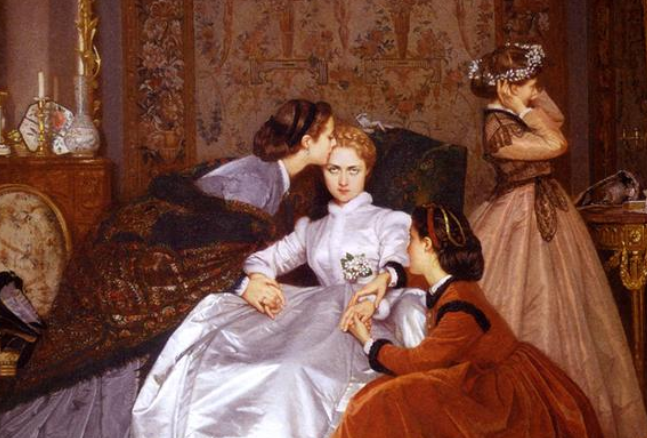“La Fiancée Hesitante”: Unveiling the 19th-Century Portrait of Female Rage
In the masterpiece “La Fiancée Hesitante” (The Reluctant Bride) by French master Auguste Toulmouche, painted in 1866, a bride adorned in opulent white sits surrounded by two comforting women. Despite the soft scene, her eyes reveal a rebellious and disgruntled spirit, making this canvas a newfound symbol of female rage. This 19th-century painting has recently gained popularity on social media platforms such as TikTok, Facebook, and Instagram, where it is celebrated as a powerful depiction of feminine emotion and resistance.
The Enigmatic Bride and Theatrical Setting
While the identity of the bride remains a mystery, Toulmouche’s affluent protagonist wears a fur-trimmed high-neck silk gown, gazing intently at the viewers. The theatrical setting features rich furnishings that accentuate the height of the room, adorned with intricate tapestries. The canvas was exhibited at the Paris Salon of 1866 and Exposition Universelle of 1867 in Paris.
Toulmouche’s Artistic Style and Romantic Movement
Toulmouche, a practitioner of the Romantic movement, emphasized emotion, individualism, and a glorification of the past and nature. Specializing in fashion painting, a popular 19th-century Parisian style depicting elaborate garments and luxurious interiors, he shared the genre with artists like Jules Emile Saintin and Charles Joseph Frederick Soulacroix.
The Artist’s Journey and Influence
Born in Nantes, France, in 1829, Toulmouche joined the studio of Swiss artist Charles Gleyre in Paris at the age of 17. Early recognition led to his exhibition at the prestigious Paris Salon by 1848. Toulmouche, a mentor to Claude Monet upon the latter’s arrival in Paris in 1862, continued to influence academic painting while subtly incorporating Japanese elements in his later works.
Trending Across Platforms
Though Toulmouche may not be as widely celebrated outside of France, “La Fiancée Hesitante” has found a massive following on social media in recent months. Shared on Facebook and Twitter, and featured on numerous Instagram pages, the artwork has inspired memes and discussions. Some relate to the bride’s disillusionment with gender roles, while others interpret her gaze as reluctance toward arranged marriages, prevalent in 19th-century France.
Celebrating Emotion and Resistance
The resurgence of interest in “La Fiancée Hesitante” highlights its timeless resonance. Whether expressing discontent with societal norms or resisting traditional expectations, the bride’s unfiltered emotions resonate with contemporary audiences, celebrating the enduring power of art to communicate universal emotions.
Month: Current Affairs - November, 2023
Category: Art & Culture Current Affairs








